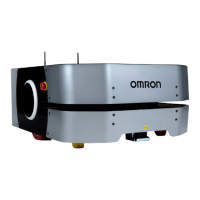158 LD-250 Platform User's Guide 20472-000 Rev B
8.9 Maintaining and Replacing Batteries
Do not disassemble the sensor cover. If dust or dirt get onto a sensor it is not possible to safely
clean it and you must replace the sensor array.
See also: Rear Sensor on page 134
8.9 Maintaining and Replacing Batteries
Maintaining Batteries
Maintain batteries as follows:
l
Every six months, inspect batteries (both stored and in-use) for damage or leaks.
If a battery is leaking, do not expose it to water. If possible, submerge it in mineral oil.
Contact your local Omron Support immediately for disposal instructions.
l
Store batteries fully charged and upright at (one month) +5 to 45°C (41 to 113°F); (one
year) 20 to 25°C (68 to 77°F).
l
Every six months, charge stored batteries to a full charge.
Replacing the Battery
The battery is expected to last for approximately 2000 recharge cycles. There are no user-ser-
viceable parts inside the battery case. Do not open it.
WARNING: PROPERTYDAMAGE RISK
Replace the battery only with an Omron factory-supplied battery intended for
use in the LD-250. Do not use batteries intended for use in other Omron LD-
series AMR models.
WARNING: FIRE AND TOXICITYRISK
Do not dispose of the battery in a waste stream that might result in incin-
eration or crushing. Safely dispose of the battery through a designated facility
according to all local and national environmental regulations regarding lith-
ium battery disposal.
CAUTION: PROPERTYDAMAGE RISK
Follow appropriate ESD procedures during the removal and replacement oper-
ations.
Removal
The battery lasts for approximately 2000 recharge cycles however, you might need to remove it
more frequently if you use a daily manual charging schedule. Some service operations also
require that you remove the battery for safety.
CAUTION: PERSONALINJURYRISK
The battery weights 19 kg (42 lb). Use safe lifting practices when removing or
installing the battery.

